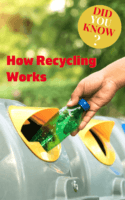Katie drank her can of Coke finish and then dumped the can in the bin.
“You could have recycled that you know,” her friend Sipho said.
“Oh, shoot, I forgot!” she said.
Often we forget to recycle, and don’t think about what happens to that can or packet we toss in the bin. But they don’t go away… and think how many things get thrown away every day. We are creating mountains of rubbish all over the world. So let’s look at what is recycling all about, and how we do it.
What is recycling?
You might have heard of the three Rs: reduce, reuse, recycle.
Reduce – the first R – means – if you don’t need something, don’t buy it! The less ‘stuff’ around, the less there is to throw away.
And next R is reuse, which means using something again instead of just throwing it away. Many things can be used again, sometimes for a different purpose (for example here you can see how to use a cardboard box to make a bookshelf! And we’ll be having more on this theme later…)
And then the third R is Recycling. This is basically making waste into something brand new, instead of throwing it away. It is the process of converting waste materials into new materials and objects, so transforming them and making them ‘new’, not just re-using them.
Why is recycling important?
Recycling is important because it reduces waste, air, and water pollution. Recycling reduces the need for extracting, refining and processing raw materials to create new products – and these processes cause water and air pollution. Also, when we recycle, the amount of rubbish which is sent to landfill sites gets reduced (think of the mountains of rubbish that don’t disappear, but just get bigger and bigger..) Recycling also creates jobs and saves money and energy.
How does it work?
The whole process of recycling can be broken into three main steps.
Step 1: Collecting and sorting:
In this stage, waste materials are collected and then processed and sorted according to their type and use (eg cans, plastic, paper, etc)
There are many informal waste pickers who go through rubbish to find recyclables and sell them on to be used in the manufacture of new products. There are also bottle banks and other places where people are able to drop off their recyclables. Some areas even have recycling services. And sometimes recyclables are later extracted from waste at the dump.
You can help this process by separating your recycled items in a separate bag, and also giving things like tins or jars a rinse, so they are not too mouldy and dirty.
Step 2: Manufacturing:
This is the phase where the collected and sorted materials are processed into new reusable products. There are special factories that buy recyclables and are able to use this material in their manufacturing processes.
Step 3: Selling recycled products to consumers:
People then buy the recycled products. And, when the product that the consumers bought already served its purpose, the recycling process will then again continue as these products are collected.
Here are a few items that can be recycled:
• Cool drink cans
• Food tins and food jars
• Metal lids of glass jars
• Aluminium cans (eg: Red Bull)
• Foil and foil packaging
• Paint, oil, and aerosol cans (leave labels on them so recyclers can see whether they contain hazardous material).
• White office paper
• Magazines and books (as long as nothing is laminated)
• Newspaper
• Cardboard boxes
• Plastic ice-cream containers
• Rechargeable batteries
Just because it is important to recycle, doesn’t mean everything can be recycled.
Here is a list of things that can’t be recycled:
• Drinking glasses
• Light bulbs
• Laminated paper
• Stickers
• Disposable batteries
• Greasy pizza boxes
• Ceramics
• Cups and saucers
• Ovenware
• Ceramic ware
• Mirror glass
• Fluorescent tubes
• Light bulbs
• Windscreens
• Car lights
• Windowpanes
So remember to do your bit by recycling where you can, so that we do not one day get buried by our own waste!
***
If you enjoyed this, you might want to know how to make money from waste here.
Tell us: Do you now know how recycle works?


